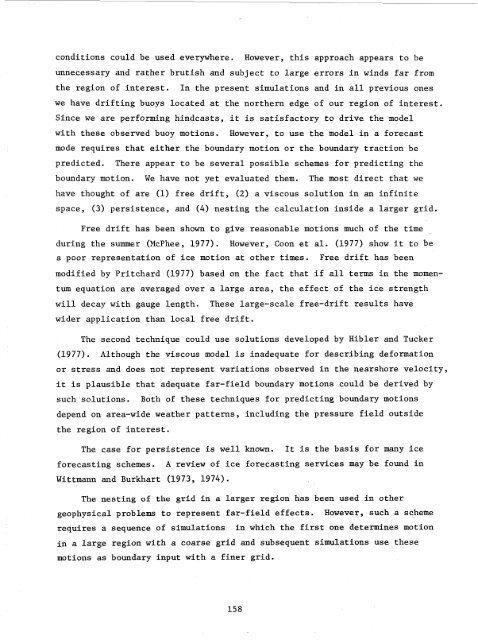AIDJEX Bulletin #40 - Polar Science Center - University of Washington
AIDJEX Bulletin #40 - Polar Science Center - University of Washington
AIDJEX Bulletin #40 - Polar Science Center - University of Washington
You also want an ePaper? Increase the reach of your titles
YUMPU automatically turns print PDFs into web optimized ePapers that Google loves.
conditions could be used everywhere. However, this approach appears to be<br />
unnecessary and rather brutish and subject to large errors in winds far from<br />
the region <strong>of</strong> interest. In the present simulations and in all previous ones<br />
we have drifting buoys located at the northern edge <strong>of</strong> our region <strong>of</strong> interest.<br />
Since we are performing hindcasts, it is satisfactory to drive the model<br />
with these observed buoy motions. However, to use the model in a forecast<br />
mode requires that either the boundary motion or the boundary traction be<br />
predicted. There appear to be several possible schemes for predicting the<br />
boundary motion. We have not yet evaluated them. The most direct that we<br />
have thought <strong>of</strong> are (1) free drift, (2) a viscous solution in an infinite<br />
space, (3) persistence, and (4) nesting the calculation inside a larger grid.<br />
Free drift has been shown to give reasonable motions much <strong>of</strong> the time<br />
during the summer (McPhee, 1977). However, Coon et al. (1977) show it to be<br />
a poor representation <strong>of</strong> ice motion at other times. Free drift has been<br />
modified by Pritchard (1977) based on the fact that if all terms in the momentum<br />
equation are averaged over a large area, the effect <strong>of</strong> the ice strength<br />
will decay with gauge length. These large-scale free-drift results have<br />
wider application than local free drift.<br />
The second technique could use solutions developed by Hibler and Tucker<br />
(1977). Although the viscous model is inadequate for describing deformation<br />
or stress and does not represent variations observed in the nearshore velocity,<br />
it is plausible that adequate far-field boundary motions could be derived by<br />
such solutions. Both <strong>of</strong> these techniques for predicting boundary motions<br />
depend on area-wide weather patterns, including the pressure field outside<br />
the region <strong>of</strong> interest.<br />
The case for persistence is well known. It is the basis for many ice<br />
forecasting schemes. A review <strong>of</strong> ice forecasting services may be found in<br />
Wittmann and Burkhart (1973, 1974).<br />
The nesting <strong>of</strong> the grid in a larger region has been used in other<br />
geophysical problems to represent far-field effects. However, such a scheme<br />
requires a sequence <strong>of</strong> simulations in which the first one determines motion<br />
in a large region with a coarse grid and subsequent simulations use these<br />
motions as boundary input with a finer grid.<br />
15 8








